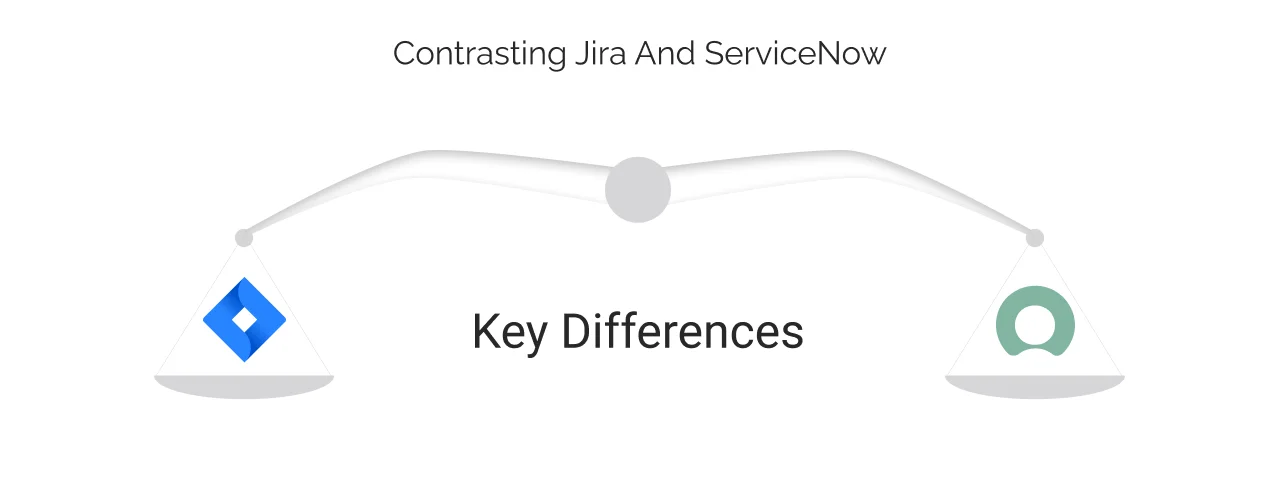Jira vs ServiceNow: Which One to Choose?
Table of Contents
Jira and ServiceNow are two leading enterprise solutions that play an integral role in the smooth operation of businesses worldwide.
Each tool, with its broad range of products, features, and capabilities, promises to bring intelligence into the business process, automate the work, and digitally transform your business for impactful outcomes.
Jira vs ServiceNow: Which tool can live up to its promise for your business? This blog will walk you through the capabilities of both, their similarities and differences, and when to choose which one. With these insights, you can opt for the right solution for your business.
Let’s start with a brief introduction to ServiceNow and Jira.
Jira vs ServiceNow: Brief Overview


Jira was introduced by an Australian-based company, Atlassian, in 2002. The first product it introduced was Jira software, a project management tool that acts as a centralized platform for task management, bug tracking, and helping teams organize their tasks according to priority.
Jira expanded its offering to stay relevant in the growing market and became the choice for different industries and teams with diverse needs. Over the years, it has introduced products such as Jira Align, Jira Service Management, Jira Work Management, and Jira Product Discovery. These products deal with optimizing IT operations, business service desks, strategic product and portfolio management, and more.
ServiceNow was founded in 2004, and the IT Service Management product was its initial offering. Since then, ServiceNow has expanded its horizon by including products such as ServiceNow ITOM, HR Service Delivery, Customer Service Management, Workplace Service Delivery, Field Service Management, and more. These applications focus on automating your entire business operational ecosystem.
Jira vs ServiceNow: What are the Similarities?
Jira and ServiceNow are both leading workflow and issue management platforms. Hence, they have overlapping capabilities. Let’s discuss the same:
- IT Service Management
- HR service management
- Customer service management
- Agile project management


Here is a detailed overview of each of these capabilities that will help you understand better:
IT Service Management
Jira offers Jira Service Management (formerly known as Jira Service Desk) as its ITSM solution that supports IT teams to deliver an exceptional service experience to customers and employees alike.
ServiceNow, on the other hand, has ServiceNow IT Service Management products. This is a solution for businesses of all sizes to bring together IT services and tools on a single platform to achieve modern IT excellence.
Similarities between Jira Service Management (JSM) and ServiceNow ITSM.
| Jira Service Management vs. ServiceNow ITSM | ||
|---|---|---|
| Functionalities | Jira Service Management | ServiceNow IT Service Management |
| Incident Management | Bring development and IT teams on the same page to enable rapid response and resolution of incidents. Capture incidents through the portal, email, and integrated applications in one place. Auto-categorize these incidents based on certain criteria using AI and designate priority and critical incidents. Notify your stakeholders about updates and status across multiple communication channels. | Users report incidents via the portal and other interaction channels. The Now Assist, a generative AI capability, enables intelligent routing and built-in tools that resolve issues promptly and restore services. It supports Major Incident Management, which is a separate process designed to look after high-impact incidents. |
| Request Management | A simple and intuitive portal for employees to seek help through knowledge articles. You can create guided request forms for different request types and define automatic approvals and manual review steps. Users can submit access requests, password resets, and more through this portal. | AI-powered self-service portals enable employees to request products or services intuitively. Your employees can request hardware, software, access, and other online services from any device. Predefined rules and approvals help auto-approve basic requests, while requiring human intervention for sensitive requests such as access and permissions. Conversational catalogs and Now Assist (Now LLM) help users find and populate relevant form items via chat. |
| Problem Management | It supports all stages from problem logging, scope, and root cause investigations to resolutions for effective problem management. You can identify recurring issues proactively through dashboards and link them to one ticket. It helps know the causes and resolve errors, allowing efficient problem resolution. | A single system of record enables easy identification and addresses issues by minimizing downtime. It offers a Known Error Database (KEDB) that is a catalogue for known issues and documented workflows. |
| Knowledge Management | With a vast knowledge base of articles, it surfaces relevant articles to help customers and employees resolve issues themselves. Users can get help over Slack and the virtual agent directly. You can also track article usage and performance of supporting resources in order to improve content. | ServiceNow agents and users can author and publish contextual articles within the platform. While they can access a knowledge base driven by AI in direct chat to provide proven resolutions to boost self-service. It tracks an article’s effectiveness, search behavior, and gaps in knowledge, which helps in refining content. |
| Change Management | By providing full context about the change, it scores the risks involved and configures approval workflows to ensure successful change implementation. You can assess dependencies, visualize the change impact, and leverage the change calendar for seamless risk assessment and scheduling. | You can log, route, and track varied changes such as normal, standard, and emergency changes. You get a CAB (Change Advisory Board) workbench, which helps manage change meetings. Along with this, you get risk scoring and a visual change calendar to overview the effect of changes. Access the dependencies seamlessly, perform risk assessment, look into data-driven flows, and use dynamic approval policies to accelerate the change by delivering value. |
| Asset Management | From tracking physical and digital assets and populating asset repositories to asset recommendations, it does it all. You get automated notifications and updates for asset expiry, therefore helping you manage the asset lifecycle. Using this, simply monitor asset health and compliance to maximize their value. | You get a unified repository of all the assets that are auto-tracked, be they hardware, software, network, or cloud. It builds a visual dependency map of them. It manages assets from procurement to retirement. It helps throughout the asset lifecycle from procurement, deployment, and maintenance to retirement. |
| Service Level Agreement | It enables you to define SLAs. | SLAs strengthen the relationship between the service provider and the business by establishing expectations. |
This is just a granular overview of the Jira Service Desk vs. ServiceNow ITSM capabilities overlapping with each other. The scope of these functionalities varies between these platforms. We’ll discuss those differences later in this blog.

HR Service Management
Human Resource Service Management (HRSM) functionality is a subset of Jira Service Management. This helps HR teams manage all their operations, automate repetitive tasks, and more.
ServiceNow has a dedicated product known as ServiceNow HR Service Delivery. It helps businesses manage HR operations such as effective staffing and employee onboarding & offboarding to oversee the performance of workers within the organization.
Let’s see how Jira HR Service Management (HRSM) stacks up against ServiceNow HRSD.
| Jira HR Service Management vs. ServiceNow HRSD | ||
|---|---|---|
| Functionalities | Jira Service Management | ServiceNow IT Service Management |
| Employee onboarding & offboarding | It allows you to create workflows for HR processes such as employee onboarding & offboarding. These workflows are standard for all department employees and deliver the same consistent experience. | It also helps HR teams to automate the process of employee onboarding and offboarding. |
| Self-service portals | It features a customizable help center that enables employees to access all organizational services and submit requests, allowing them to find the help they need themselves. | It allows the creation and configuration of self-service experiences to enable employees to avail self-services intuitively. |
| Service Level Agreements (SLAs) | Project admins can set up customizable SLAs for different request types. They can define an SLA to plan which tasks should be resolved first and the timeframe in which they can be resolved. SLAs are directly integrated with HR case/issue queues, enabling your agents to see which cases are close to breaching. Therefore, they can prioritize them effectively. Moreover, they can track progress. | An SLA can be created to establish the terms and conditions for HR teams to deliver the help and guidance employees need. ServiceNow has a built-in SLA policy engine that tracks, measures, and enforces time commitments across HR cases. It offers HRCase SLAs for HR specific scenarios. |
| Automation | It has low-code, no-code automation capabilities and AI agents to automate repetitive tasks. | It also has low-code tools powered by GenAI, such as Now Assist, and autonomous AI agents with contextual relations to automate the HR processes. |
Customer Service Management
Customer Service Management is again a subset of Jira Service Management, offering a unified view for your development and support teams. This enables parallel and up-to-date customer insights for both teams.
Pre-built customer templates and auto-populated solution suggestions from your knowledge base help your customer support executives focus on complex issues while handling basic ones independently.
Its basic functionalities include SLAs, answering customers’ questions, prioritizing inquiries, and collecting customer feedback to deliver exceptional experiences.
On the other hand, ServiceNow Customer Service Management is a tool built for this single cause. It is driven by AI-powered self-services, enabling users to solve issues quickly and delight customers.
Its features include omnichannel customer support, case management, SLAs, issue resolution, knowledge management, and task intelligence.
ServiceNow AI agents deflect repetitive and basic customer cases, freeing up human agents’ time to focus on complex issues. Gain an understanding of how organizations are leveraging ServiceNow AI agents for customer support.
Agile Project Management
Jira Align helps organizations scale agile practices and improve the communication between business and technology operations to increase the certainty of achieving expected outcomes. You get a separate dashboard for forecasting, simulation, risk tracking, reports, and other project management features.
A simplified view of cross-dependency mapping, visualization, and resource allocation across projects enables easy understanding. It also helps spot inefficiencies.
ServiceNow has Agile Development, helping organizations to prioritize, plan, and manage projects to support the strategic objectives of an organization. Furthermore, it simplifies the execution of projects, enabling them to deliver products or services faster.
It offers scrum boards to map out dependencies and agile dashboards to view trends and sprints. Not only on your desktop, but also manage everything on the go with Agile management mobile.
ServiceNow Agile Development comes with additional functionalities like:
- Agile development 2.0: Plan and track scrum work with clear epic-level insights for product owners and scrum masters.
- Agile boards: Organize and manage tasks, stories, and issues in one visual board.
- Agile team planning: Connect agile work items across your developer tools for easier team coordination.
- Agile performance analytics: Access ready-made dashboards to analyze epics, sprints, releases, and team performance.
Cloud-First Platforms
ServiceNow and Jira both are cloud-first platforms. They come with cloud deployment options that enable you to leverage the scalability of the cloud.
Jira vs ServiceNow: What are the Differences?


Now, let’s boil down the Jira vs. ServiceNow comparison to the differences. These differences will help you find out which solution has better potential to meet your specific business needs.
Jira is a Versatile, High-Velocity ITSM for Agile Teams, While ServiceNow is a Comprehensive ITSM for Large Enterprises
Jira Service Management is a high-velocity ITSM solution designed for agile teams. It is often considered the best choice for smaller to mid-sized organizations for managing and delivering high-quality IT services.
Jira Service Management includes a comprehensive set of features designed to support IT and service teams in delivering fast, efficient service management. You get ITSM, ITOM, asset management, customer service management, dashboards, and reporting functionalities as a subset of this module. For additional capabilities, you have to rely on third-party applications.
ServiceNow offers comprehensive and separate yet integrable products for all your specific needs.
- ServiceNow ITSM for managing IT services
- ServiceNow Customer Service Management for customer support and services
- ServiceNow HR Service Delivery for managing HR cases and automations
Apart from this, ServiceNow offers a wide range of products for specific service delivery. These include:
- ServiceNow ITAM for managing enterprise-wide assets
- ServiceNow ITOM for managing enterprise operations
- ServiceNow Security Operations for prioritizing and responding to vulnerabilities.
- ServiceNow Field Service Management for managing field operations, dispatchers, field technicians, and more efficiently.
- ServiceNow Strategic Portfolio Management to manage everything from business strategy to outcomes.
- Enterprise Service Management (ESM)
With a product focusing on a single business domain and service delivery, ServiceNow eliminates the reliance on third-party applications.
While both platforms are ITIL supported, Jira is less extensive with out-of-the-box ITIL features than ServiceNow. ServiceNow offers deeply integrated ITIL processes and sophisticated automations.
Jira’s User Interface is More Accessible, While ServiceNow has a Complex and Technical User Interface
Jira’s user interface is intuitive and simple to use, enabling users to get the information they need. It has several areas, such as header, navigation, content, and footer.
The header has the logo, redirecting users to the homepage, along with a search bar, notification, profile, and easy chat options.
The customizable navigation area provides access to the sections of Jira, such as projects, issues, filters, destinations, and more.
The content area enables users to view and interact with the project and issues. It also offers quick navigation shortcuts to places you frequently visit and a recommended for you section to seek relevant help.
The footer area has links to Jira’s documentation, support resources, and community forums.
The user interface of Jira is customizable, making it easy the users to adapt it according to their preferences.
ServiceNow has a web-based user interface that allows users to access the information on the platform. Its user interface has areas such as banners, navigation, content, and a footer.
The banner part resides at the top and contains a logo, navigation menu, and a search bar. The navigation part provides access to the main sections of ServiceNow, allowing you to navigate to any module of the present instance.
The workspaces tab navigates you to all your workspaces quickly. The Favorites tab is one of the unique features in which you can bookmark pages you frequently visit.
Type anything in the search bar, be it an incident number, a knowledge base answer, or a feature you need help with.
The content part is where all the information related to operations and modules is available. The footer has links to documentation, support resources, and community.
Jira is Agile for Growth, and ServiceNow is Built for Volume
Scalability is an important factor to consider in a growing business, and both Jira and ServiceNow are scalable solutions.
Jira has the capabilities to handle enterprise-level operations, but it lacks the functionalities when compared to ServiceNow. It is more agile and is best suited to handle the needs of smaller organizations. Also, as the Jira instance grows, the speed may be influenced by factors such as the number of issues, custom fields, and users, resulting in downtime.
Jira does not offer data centers but allows businesses to establish their own. You can leverage the data center solution, self-host it, and run it on your own server. You get a 30-day trial period for the same.
ServiceNow is a scalable solution with 22 global datacenters around the world, capable of handling the operations of large-scale enterprises. These are arranged in active-active pairs to ensure high availability. Furthermore, it has a scalable package that is tailored to fit the needs of an organization.
Jira Offers Customizability, While ServiceNow Excels in Enterprise-Level Customization
Here is a detailed breakdown of Jira vs. ServiceNow customization capabilities. Jira has the following customization options:
- Jira Service Desk allows workflow customization, design ticket forms, and integrations with other tools to adapt to your needs.
- You can customize the view of the project workflow on your Jira project board.
- Reporting dashboards can be customized.
- You can also write custom scripts to satisfy unique needs.
- Custom fields can also be created to collect specific information about the customers.
- It has an app-building tool called Forge that allows the development of applications using JavaScript, HTML, and CSS.
ServiceNow, on the other hand, has better customization capabilities compared to Jira. Here is a brief of the customization opportunities available in ServiceNow:
- It allows you to write custom HTML code for UI pages.
- ServiceNow allows you to extend the platform’s capabilities without modifying the baseline installation code.
- UI policies allow you to control the behavior of the user interface with clicks rather than code.
- You can develop a scoped application tailored to meet your organization’s specific needs.
- By writing an Automated Test Framework (ATF) to ensure the rigorous testing of each customization.
- With HealthScan, you can identify the integrations that are not working as expected or are no longer required.
- You can create deeply tailored workflows, complex business rules, UI policies, and automations.
ServiceNow is a preferred choice for organizations that seek customization. It has a comprehensive canvas for enterprises to tailor the solution that truly reflects their needs.
Jira and ServiceNow Both have a Wide Range of Integrations, But ServiceNow is Better
ServiceNow and Jira both have a wide range of integration capabilities. However, they differ based on the scope and nature of these integrations.
Jira has a developer-friendly interface, readily available documentation, and APIs that contribute to the development of custom integrations. Furthermore, it has an Atlassian Marketplace that allows access to third-party add-ons or integrations that can be integrated with Jira products.
ServiceNow, as said, is a comprehensive enterprise workflow tool built on the ServiceNow AI Platform. It is powered by one platform, one data model, and one architecture, enabling all ServiceNow products to integrate seamlessly with each other. It can also be integrated with third-party applications and data sources.
It offers support for different integration techniques, including web services, LDAP (Lightweight Directory Access Protocol), JDBC (Java Database Connectivity), SOAP (Simple Object Access Protocol), REST (Representational State Transfer), WSDL (Web Services Description Language), and more. Furthermore, it has a MID server enabling API and command-line integration.
ServiceNow has a collection of pre-built integrations to ensure it performs integrations easily without working on them from scratch.
Jira and ServiceNow both offer AI capabilities
Jira and ServiceNow, both platforms, offer AI capabilities, but they differ significantly in functionality.
Jira’s AI features are limited and mostly assistive, primarily focused on productivity enhancements.
- Jira AI (Atlassian Intelligence): Creates smart summaries for ticket details and comment history, AI-generated descriptions for tickets, basic automation using natural language (such as routing and auto-labelling), generates SQL queries and chart insights, identifies gaps in the knowledge base, and resolves incidents faster.
- Jira AI agents: These agents are assistive agents that look into customer requests and answer them with relevant resources. The agents match the request intent and proceed with a relevant answer. If they are not confident with the intent request, they search across the knowledge base and answer with a relevant resource.
- Atlassian ROVO: An AI assistant that allows users to search across Atlassian tools (Jira, Confluence, etc.) and provide contextual answers based on company knowledge. It offers Rovo search (helps teams find valuable information without switching tabs), Rovo Chat (personalized answers), and a Browser Extension.
ServiceNow’s AI Capabilities include an extensive range of generative AI capabilities and autonomous agents. It has AI built into its platform that empowers every product.
- Now Assist, its generative AI capability, uses your linked knowledge base to directly answer user questions without needing an intent. It is ideal for straightforward informational queries.
- Generate dynamic case summaries and suggest fixes.
- Generative AI for app development leverages low-code AI tools in ServiceNow App Engine.
- Virtual Agent chatbots handle complex customer/employee queries without human help.
- ServiceNow AI Agents are autonomous, advanced agents that are proactive, predictive, and deeply integrated into your business workflows. Their backend is powered by machine learning frameworks, natural language processing, search, and data mining and analytics capabilities.
It simplifies work for people and offers organizations the ability to create custom AI agents as per their unique needs. These agents can work together with employees to help manage workflows.
| Jira vs. ServiceNow (AI Capabilities) | ||
|---|---|---|
| Functionalities | Jira (Atlassian Intelligence) | ServiceNow (Agentic AI) |
| AI Type | Native Generative and assistive AI and agents. You can give in-editor prompts to write, rephrase, summarize, and suggest. | Now Assist generative AI and Agentic AI Agents that summarize, resolve, respond, and perform tasks with context embeddings. |
| Work breakdown | Suggests subtasks and optionally generates child items. | It is not primarily for task planning but focuses on automating workflows and decision-making. |
| Virtual Agent and chatbot support | Generative AI to train intents, answer FAQs, drive automation flows via shortcuts/integrations | Offers conversational support, resolves requests, updates tickets, and triggers automations into workflows |
| Predictive Analytics | Minimal native capabilities. It is reliant on marketplace apps and third-party integrations | It has built-in predictive models for incidents, outages, and forecasting |
| AI Customization | Moderately customizable with rule automation and connectors | Highly customizable, as it allows you to set up and create automation workflows. Can be done using ServiceNow AI Control Tower, flow designer, integration hub, and more. |
With this comparison, we can see that Jira’s AI capabilities are limited to suggestions, responding with existing resources, and require human interaction. ServiceNow has advanced in its AI capabilities, offering autonomous and agentic capabilities at its core.


Jira has Flat Pricing, While ServiceNow has Custom Pricing
Jira has flat and transparent pricing. This means Jira has fixed pricing regardless of the quantity used, the specific features included, or the time spent providing the service. It offers 4 different pricing plans.
It offers user-based pricing, as follows (As of August 2025):
- Free (up to 10 users)
- Standard: $22,500/year for user tier 201-300
- Premium: $40,500/year for user tier 201-300
- Enterprise: This plan applies to organizations with more than 800 employees.
The features offered vary by plan, and each plan includes upgrades, additional features, and advanced features.
ServiceNow, on the other hand, has custom pricing determined based on the assessment of your business needs. It helps you create a custom plan for all your requirements, only costing you for what you need. You can discuss with a ServiceNow consultancy services provider to get the estimated cost of the platform for your business.
Jira vs ServiceNow: Which One to Choose?


The selection between ServiceNow and Jira is subject to your needs. Assess them thoroughly and choose the right solution that supports your organization’s long-term goals.
Choose Jira when:
- You are a small- to mid-sized business with simple IT needs.
- You want rapid setup with intuitive, out-of-the-box workflows.
- You require lightweight ITSM
- Editor-centric AI without heavy configurations
- You are comfortable managing your infrastructure and can self-host servers.
Choose ServiceNow when:
- If you are a large-scale enterprise with complex business needs
- When you need a complete solution for your organization with complex IT needs, from service infrastructure to asset management.
- When you want to automate your overall workflows across every business domain, such as IT, asset management, operations, customer service, and more. You get a comprehensive platform for everything.
- When you do not want to maintain your own servers
- Deep ITIL support and mature change, problem, and asset lifecycles.
- When you need AI agents that work on your behalf across business domains.
- When you need extensive customization, governance, and integration.
Summing up
Jira focuses on efficient cross-team collaborations over projects and agile management, and that too with a heritage of software development.
While ServiceNow offers a broader enterprise workflow focus. It automates your IT, HR, asset management, and more. It automates the entire operational ecosystem of your business.
Don’t Worry, We Got You Covered!
Get The Expert curated eGuide straight to your inbox and get going with the Salesforce Excellence.
AUTHOR
Shubham
Service Cloud, Salesforce Managed Packages
With over 5 years of experience, Shubham specialize in curating solutions on Salesforce Service Cloud, Nonprofit Cloud, Consumer Goods Cloud, Managed Packages, and ServiceNow ITSM. He designs and implements end-to-end service solutions that improve operational workflows and ensure seamless integration across enterprise systems. Shubham’s expertise lies in creating secure, efficient, and agile platforms tailored to unique business needs.


Cyntexa.
Join Our Newsletter. Get Your Daily Dose Of Search Know-How
Frequently Asked Questions
Yes, Jira and ServiceNow can be integrated with the help of the application OpsGenie Incident Response Orchestration Platform available on the ServiceNow store.












